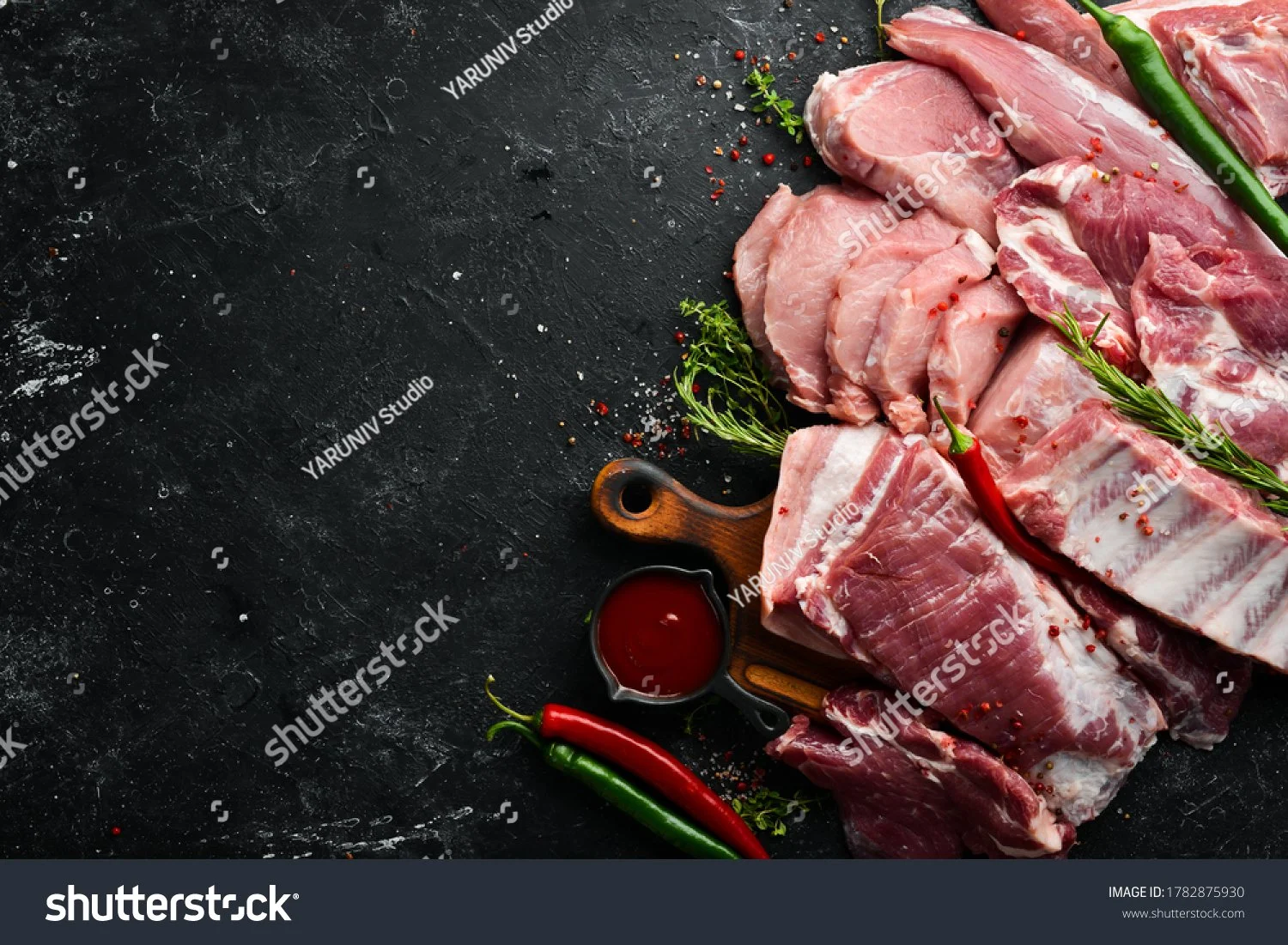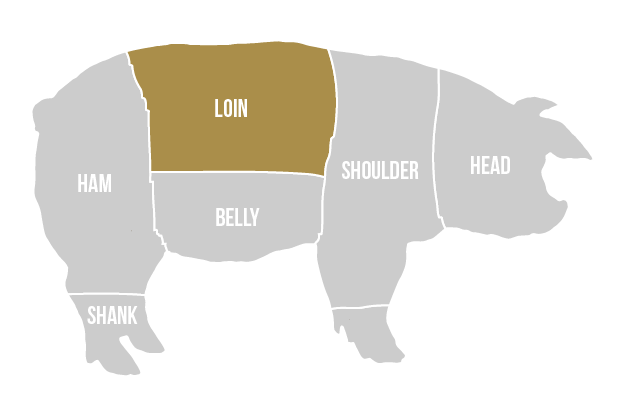
YOUR PORK.
YOUR CHOICE.
Choosing Your Pork Cuts
Processing your hog should be simple, and with us, it is. Whether you have a trailer full of hogs or a single hog raised by your kids our job is to make sure every cut is done right and exactly how you asked.
At Windthorst Custom Meat Co., we work with North Texas families, 4-H kids, and farmers who want reliable processing without the runaround. No surprises, no pressure, just clean cuts and honest service.
Scroll down to explore each primal section and see what your options are. Whether you're familiar with the process or figuring it out as you go, we’ll walk you through it.
-
Cut from the upper part of the shoulder. Well-marbled and full of connective tissue that breaks down beautifully during slow roasting or smoking. This is the go-to cut for pulled pork.
Note: Choosing a whole Boston Butt may limit the availability of steaks or country-style ribs from this section.
-
Taken from the lower half of the shoulder, this cut includes more bone and skin than the butt. It’s often smoked whole or cut into roasts.
Note: This is a separate section from the Boston Butt and does not affect your other shoulder choices.
-
A trimmed and deboned section from either part of the shoulder. Perfect for slow cookers, oven roasting, or shredding.
Note: Choosing shoulder roasts may reduce the availability of shoulder steaks or country-style ribs.
-
These meaty, boneless ribs are cut from the shoulder end of the loin or the upper shoulder. They’re not true ribs, but they cook up juicy and tender when grilled or baked.
Note: Choosing country-style ribs uses a portion of the shoulder that could otherwise be used for roasts or steaks.
-
Cross-cut from the shoulder, these steaks have rich flavor and marbling. Best when marinated and grilled or braised.
Note: Choosing shoulder steaks may limit availability of larger roasts or country-style ribs.
Loin Primal
The pork loin runs along the back of the hog, from just behind the shoulder to the start of the ham. It’s one of the most tender sections of the animal and offers a range of popular cuts — from pork chops to tenderloin and baby back ribs. These cuts are lean, easy to cook, and family favorites for everyday meals.
-
Cut across the loin, pork chops are the most familiar cut for most people. They can be bone-in for extra flavor or boneless for convenience. Great grilled, pan-seared, or baked.
Note: Choosing pork chops means you will not receive a full loin roast or baby back ribs.
-
A long, narrow, and very tender cut that runs beneath the main loin. It’s extremely lean and best cooked hot and fast. Great roasted whole or sliced into medallions.
Note: This cut is separate from the main loin and is typically included with any loin processing option.
-
A large, uniform roast cut from the center or sirloin end of the loin. Perfect for oven roasting or stuffing.
Note: Choosing a loin roast means you will not receive pork chops or baby back ribs.
-
These ribs come from the upper portion of the rib cage where they meet the backbone. They’re shorter and more tender than spare ribs and are ideal for smoking or slow-cooking on the grill.
Note: Choosing baby back ribs means you will not receive pork chops or a loin roast.
Shoulder Primal
The pork shoulder comes from the front upper leg and is a hard-working section, which means it’s packed with flavor. It’s typically split into two main areas — the Boston Butt and the Picnic Shoulder. These cuts are great for roasts, pulled pork, sausage, and grilling. While not naturally tender like the loin, the shoulder shines when cooked low and slow.
Belly Primal
The pork belly runs along the underside of the hog, just behind the shoulder and beneath the loin. It’s a rich, fatty section that offers some of the most flavorful and versatile cuts on the animal — including fresh belly, side pork, and bacon. This section can also be used for spare ribs, but you’ll need to choose which way it gets cut.
-
The full slab of belly meat with skin on or off. Known for its rich fat content and deep flavor, pork belly can be roasted, braised, smoked, or cured.
Note: Choosing pork belly means you will not receive bacon or spare ribs.
-
Sliced crosswise from the belly before curing. These are thick, unseasoned pork strips — essentially unsmoked bacon. Great fried or seared.
Note: Choosing side pork uses the same portion as bacon or belly.
-
Cured and sliced pork belly. You can choose how it’s smoked, seasoned, or cut (thin or thick).
Note: Choosing bacon means you will not receive spare ribs or whole belly.
-
Cut from the underside of the rib cage, spare ribs are meaty, flavorful, and perfect for smoking or grilling.
Note: Choosing spare ribs means you will not receive bacon, belly, or side pork.
HAM Primal
The ham comes from the hind leg of the hog. It’s a large, dense section known for its deep flavor and versatility. You can leave it whole for roasts, slice it into steaks, or have it cured and smoked. Like other big primals, you’ll need to choose how you want it broken down — you can’t have it all.
-
A full, uncured ham ready for roasting or seasoning to your liking. Great for holidays or large family meals.
Note: Choosing a whole fresh ham means you will not receive ham steaks or a cured/smoked ham.
-
Sliced cross-sections of the ham, typically cut ¾" to 1" thick. Great pan-fried or grilled.
Note: Choosing ham steaks means the ham will not be processed as a whole roast.
-
The classic preparation — brined, smoked, and ready to serve hot or cold. You can specify sliced, halved, or whole.
Note: Choosing a cured or smoked ham means it will not be processed fresh or cut into ham steaks.
-
The lower portion of the ham — rich in collagen and flavor, best used for soups, beans, or braised dishes.
Note: Hocks are usually included unless otherwise requested, regardless of how the rest of the ham is processed.
Shank Primal
The shanks are the lower portions of the front and rear legs. While tough by nature, they’re full of connective tissue and bone, which makes them ideal for slow cooking. The most common use is to slice them into hocks or leave them whole for stocks and braises. This isn’t a section you’ll get steaks or roasts from, but it’s prized for deep, hearty flavor.
-
Bone-in cuts from the lower leg, hocks are loaded with connective tissue and make excellent additions to soups, stews, or beans. They can be left fresh or smoked for extra flavor.
Note: Choosing hocks typically uses the entire shank area.
-
If you prefer, the shank can be sliced into thick cross-cut pieces with the bone in the center. This style of cut is ideal for braising and produces tender, fall-apart meat.
Note: Choosing Osso Buco-style shanks means they will not be processed as whole hocks.
Head Primal
The head may not be the first thing most folks think of, but there’s a surprising amount of usable meat in this section. Whether you're after jowl bacon, head cheese, or specialty items like ears or tongue, we can process it based on your preferences — or leave it out entirely. If you’re not using it, it typically goes to trim or discard.
-
Cut from the cheek, jowl bacon is rich, fatty, and deeply flavorful. It can be cured and smoked like belly bacon or left fresh.
Note: Choosing jowl bacon uses the cheek portion of the head and removes it from head cheese or grinding.
-
A traditional preparation using the meat from the cheeks, jaw, and snout, often cooked and set in a loaf. We can return the head whole if you plan to make this yourself.
Note: Choosing head cheese uses most of the edible meat from the head.
-
Lean and tender when prepared properly, tongue is a specialty item often used in tacos or sliced cold.
Note: Tongue can be packaged separately or included in head cheese processing.
-
Used in stock, pet treats, or traditional recipes. We can package these separately if requested.
Note: These are typically discarded unless specifically requested.






